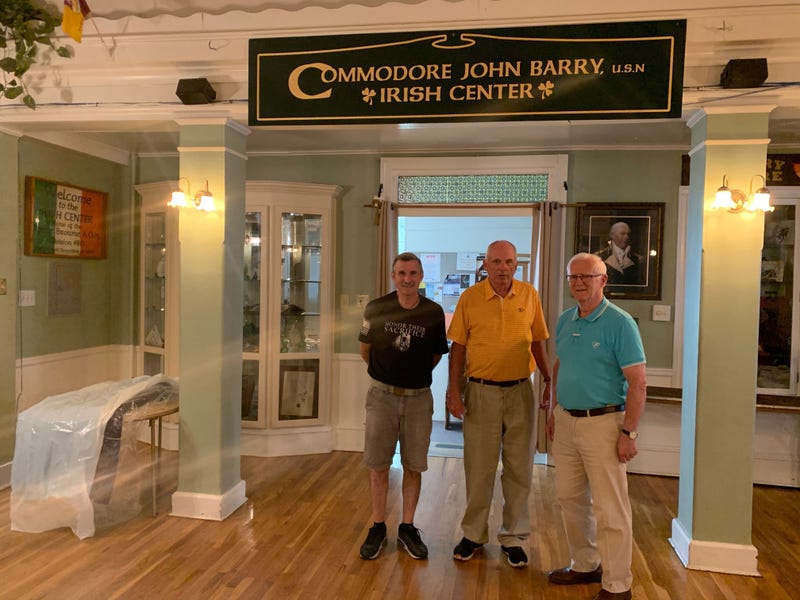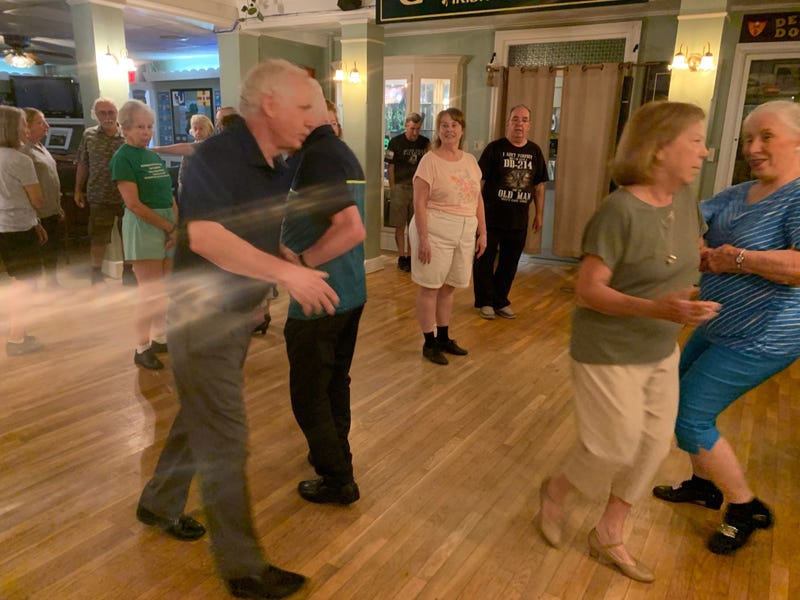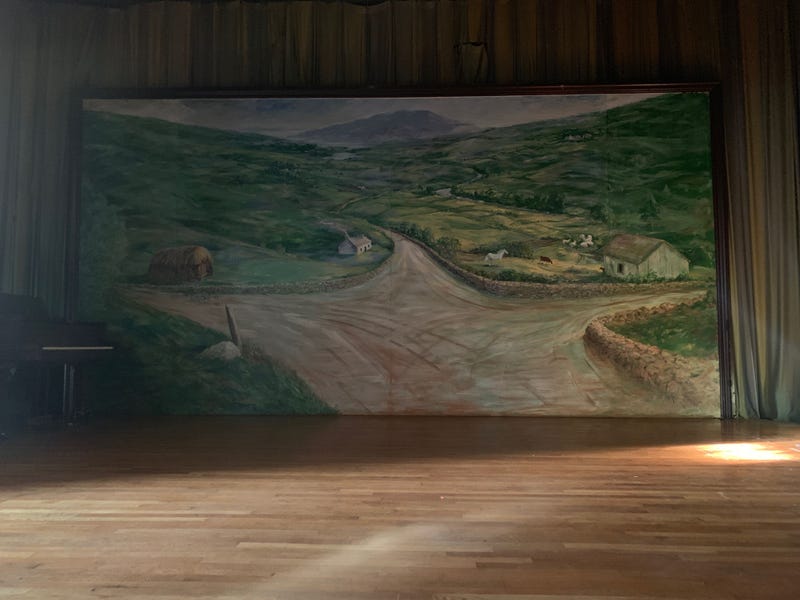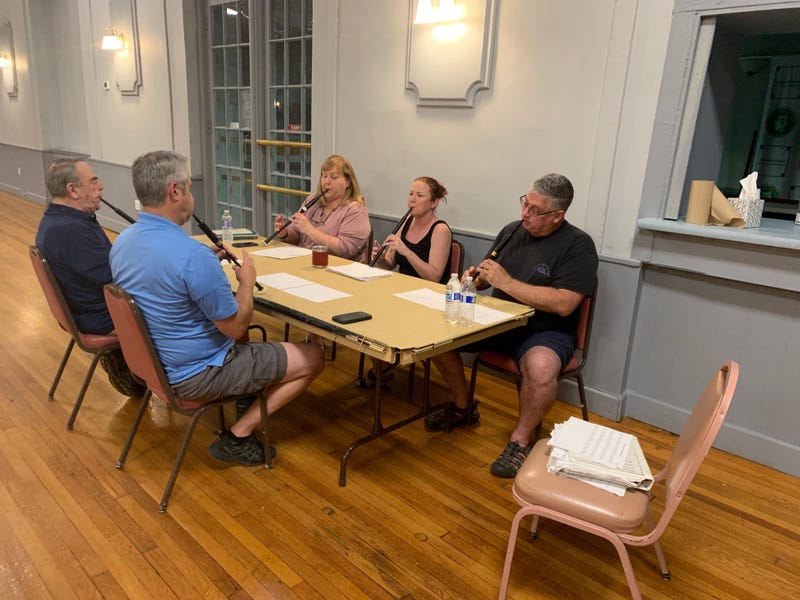
PHILADELPHIA (KYW Newsradio) — If you enter the front door of the Commodore John Barry Irish Arts and Cultural Center on a Tuesday night, you walk right into the contra dance class, an informal weekly exercise in the Irish forerunner of square dancing.
With the music playing, the stone fireplace glowing and the manager’s daughter tending bar, it feels a bit like a friendly pub from the old sod.
But in the next room, another group is practicing an Eastern European line dance. And on a different night, you might encounter Brazilian drumming or a jazz jam. On the weekend, it might host a neighborhood teenager’s quinceañera.
“If you want to be in today’s world, you can’t be just your own little entity, and the more you bring in other people, the more a success you’ll be,” said club President Sean McMenamin.
McMenamin knows a bit about the making of a success. A few years ago, the club, located on Emlen Street in Mount Airy, almost shut its doors for good, afflicted by disrepair, dwindling membership and tax debt. McMenamin is credited with the turn-around that has restored the club to vibrancy.
“Sean McMenamin saved this whole place,” said member Peri Livermore, “and he did it because he’s such a wonderful leader that he could convince people they just had to do it.”
It was not a simple argument to make.
The reason that the club exists in the first place has vanished, as McMenamin is the first to note.
“In the beginning when it opened here, you’d be 90% Irish-born, nearly,” he recalled. “We were part of that post-second World War immigration, but there’s no immigration from Europe anymore.”
Irish immigration to Philadelphia goes back to before the country itself was born. Commodore John Barry, the club’s namesake, fought in the Revolutionary War and is considered the father of the U.S. Navy.
It was the potato famine of the 1840s, though, that opened the floodgates. Irish immigrants kept coming in waves through the 1960s. They formed societies, named for the counties they called home: Derry, Galway, Mayo, Antrim and others. They provided the only safety net available.
“They had their own insurance policies and — this is the one that gets people going — they were all men,” said McMenamin. “The man had to be between 18 and 45. And you know why 45? There was a $100 death benefit. You could become a social member after 45, but you weren’t entitled to the death benefit. But what they did is for 50 cents a month, you would get six weeks of sick benefits, $5 a week. In 1906 and 1907, $5 a week can almost buy your groceries.”
In 1958, the societies decided they wanted a central meeting point and they found a sprawling stone building in Mount Airy up for sheriff’s sale. It was built in 1905 as an automobile club for well-heeled men from Germantown. Then, it became a catering hall called Ross House.
The Irish Center is its third owner in 118 years.
RELATED
“It became the center for big events,” McMenamin said. “Back in the 1960s, there’d be a thousand people here at a society ball. A lot of people met their spouses here. At that particular time, the mission was to support the immigrants coming and to have a place to call their own.”
As immigration fell off, so did membership. The building was showing its age. By 2013, conditions were dire.
“The place was falling apart and literally the tax man was at the door, at an event, saying, ‘You have to pay your taxes or we’re going to shut the place down,’” Livermore recalled. “In the ballroom, it was raining and water was running down the sides and I thought, ‘Oh my goodness.’”
McMenamin said the real catalyst for change was the “actual value” property assessment the city conducted in 2013. The tax bill the club got the next year was so far beyond its resources, it may as well have been an eviction order.
The members faced a choice: Shut the club down or invest an enormous effort in transforming it. Simply keeping the doors open was not an option. To last another 65 years, it would have to reinvent its mission as a member of one of Philadelphia’s most diverse neighborhoods while remaining an institution for a community now many generations removed from the immigration experience, and tracing their lineage to other countries of origin as well. The answer seemed easy. No one wanted to close the club. The work to save it, however, would be hard.
McMenamin had been a project manager for Dupont before he retired. He was used to coordinating many moving parts. There was a big difference, though, in overseeing the revival of the Irish Center.
“I came from working for Dupont where money was no object,” McMenamin observed wryly. “Money was no object here because there was none of it.”
The first step was to become a nonprofit. The original members had bought shares in the club, like a corporation. They’d have to surrender those. A Ballard Spahr attorney, Lisa Maloney, did the paperwork pro-bono. That allowed the club to fundraise. The community raised thousands of dollars. It was able to pay off debts and back taxes. Being a nonprofit also enabled the club to accept free work from labor unions.

“I’ll give you a silver lining to the COVID,” McMenamin said. “The union apprentices, they were unbelievable during COVID. … All the hardwood floors were done. All the energy was upgraded, and then we had construction guys to make repairs in the ballroom.”
McMenamin sat in the main room of the club, with tables on one side, a bar on the other, and in between, an open space with a large stone fireplace at one end. It’s cozy, charming and, now, also well-lit and a comfortable temperature despite the July heat outside.
But more than the building has been restored. The club is once again a hub of activity. Membership is growing again. New groups are using the facilities.
There’s a writers’ room upstairs for use by aspiring Oscar Wildes, George Bernard Shaws or other great Irish authors.
The library is a trove of documents and memorabilia: ship manifests from the famine years; the original charters of the Irish societies, dating to the 1880s. There are the minutes of a 1920 meeting of the Ancient Order of Hibernians in which they authorized a loan of $2,000 to the fledgling Irish government.
“It was paid back in 1948,” McMenamin noted.


Downstairs, there are lessons in fiddling, piping and dancing. Margaret Nolan, 34, tends bar.
“It feels like a second home,” she said. “I’ve been coming here since I was a kid. So many family events have happened here. It’s been really cool to see this back end of it and know what it means to people — so many people who’ve been coming here for decades. It’s really cool to feel a part of that continuity between generations and between here and Ireland.”
McMenamin, now in his 80s, is looking for someone to take the torch. Whoever it is will preside over a very different club than the one McMenamin entered as a young, single new American in 1968.
“Every first Friday we have all the Irish musicians come in here. There were 23 last week here and I don’t think one of them was born in Ireland,” he said, “so it just shows you to continue the connections here, it’ll be the culture, the Irish dance, the music and now we have a new group here. They play Irish football and hurling. So that’s our connection now. It’s not immigration. It’s evolved to meet today’s needs from what the original needs were.”

